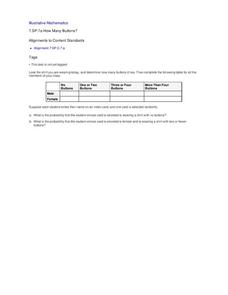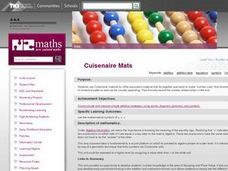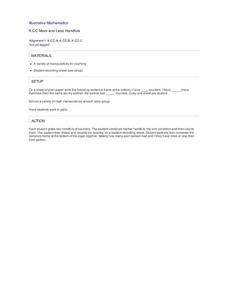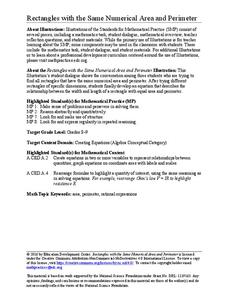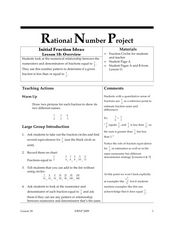Curated OER
Unequal Groups vs. Equal Groups
Third graders create their own chenille stems to use during this and future lessons. As a class, they discuss the difference between equal and non-equal groups. In groups, they brainstorm a list of items that come in groups of two,...
Curated OER
Addition: Grouping Property
In this using the grouping property to add worksheet, students find the sum of one side and fill in the blank to make the other side of the equation equal. Students solve six problems.
Curated OER
How Many Buttons
Help learners explore the concepts of more than, less than, and equal to. They participate in a button attribute activity, play a game using buttons and a die, draw the sets of buttons in their journal, and play button bingo.
Curated OER
One and Tens Place Value - Step-by-Step Lesson
Give your pupils a grasp of place value in a two-digit number. They see a drawing of counting cubes in a stick of ten, then examine a set of four. Mathematicians determine how many blocks there are by grouping the tens. Ideally, you will...
Curated OER
Cuisenaire Mats
First graders use Cuisenaire rods to study the mathematical symbols =, <, > for the relationships is equal to, is less than, and is greater than. They use the rods to show visual explanations of common number combinations.
Curated OER
Ones and Tens Place Value
As scholars examine place value, these exercises help them incorporate addition and grouping. First, they answer three missing-addend questions, each with 10 as the given addend. Because all of the missing numbers are single-digit, this...
Curated OER
Equal or Not Equal
Tiny mathematicians count the number of shapes (up to 8) in pairs of object groups and identify the sets as equal or not equal. Five practice problems. They also draw 2 groups of shapes that are not equal. A focused tool that requires...
Curated OER
Dividing Using Groups
Three simple slides show the relationship between division and multiplication. Items are grouped into equal sets based on the division problem presented, then related to repeated addition and multiplication.
Illustrative Mathematics
Equal Area Triangles on the Same Base II
A deceptively simple question setup leads to a number of attack methods and a surprisingly sophisticated solution set in this open-ended problem. Young geometers of different strengths can go about defining the solutions graphically,...
Education Development Center
Interpreting Statistical Measures—Class Scores
Explore the effect of outliers through an analysis of mean, median, and standard deviation. Your classes examine and compare these measures for two groups. They must make sense of a group that has a higher mean but lower median compared...
Curated OER
More and Less Handfuls
Working as a pair, two kindergartners will sit at a table and will pick two handfuls of counters. They will combine their individual handfuls into one, and count their own selection. They will then draw and record their count on a record...
CK-12 Foundation
Data Summary and Presentation: Chart for Grouping Data
Get social! Create a display of social media use for a class. Pupils use provided information about the time spent on social media to construct a histogram. Using the histogram, learners interpret the data to answer questions.
CK-12 Foundation
Repeating Decimals: Does 1 equal 0.999... ?
Six questions make up a challenging interactive that tests scholars' knowledge of repeating decimals. Mathematicians answer true or false and multiple-choice questions with help from a tool that highlights decimal movement in an...
Curated OER
Model Repeated Groups
In this repeated groups worksheet, students use equal-shares drawing to solve a word problem, analyze and explain the process, make equal share drawings for 30 marbles and "explore it."
Illustrative Mathematics
Counting Dots in Arrays
Mathematical arrays can represent several different math skills, including counting groups, multiplication, and even area. In this specific task, learners are asked to identify the addition equations that are equal to a 3 x 4 array....
Curated OER
Unit 8 Algebra: Brackets
In this expansions worksheet, students use area to solve expansions of brackets problems. There are 4 of this type, each problem having less guidance than the previous. The second activity asks students to solve magic square puzzles...
Fuel the Brain
Equal Grouping
Using division can be challenging for some young learners. However, these problems that are simple division without remainders, are designed to help your learners both conceptualize and visualize the problem before solving.
Illustrative Mathematics
Fruit Salad
Playing with values in this fruit salad problem allows learners to find out how many cherries were mixed in. Your middle schoolers can organize their thoughts in a chart before going into the equation. Eigth graders can skip the chart...
EngageNY
The Difference Between Theoretical Probabilities and Estimated Probabilities
Flip a coin to determine whether the probability of heads is one-half. Pupils use simulated data to find the experimental probability of flipping a coin. Participants compare the long run relative frequency with the known theoretical...
EngageNY
Estimating Centers and Interpreting the Mean as a Balance Point
How do you balance a set of data? Using a ruler and some coins, learners determine whether the balance point is always in the middle. Through class and small group discussions, they find that the mean is the the best estimate of the...
Education Development Center
Rectangles with the Same Numerical Area and Perimeter
Is it possible for a rectangle to have the same area and perimeter? If you disregard units, it happens! In a challenging task, groups work to determine the rectangles that meet these criterion. The hope is that learners will naturally...
Curated OER
Initial Fraction Ideas Lesson 15: Overview
Observe fraction numerators and denominators to determine if they are less than or equal to 1/2. In this fractions lesson plan, students simplify fractions and determine their relationship to 1/2.
Curated OER
Let's Count to 20
Budding mathematicians create groups of 10 to 20 objects using numerals to record the size of a group. They construct sets of numbers up to 10, write the numerals up to 10, and count up to 10 rationally. Learners also use ten frames and...
Curated OER
Team Up
Learners discover how to break into equal teams. In this dividing instructional activity, students break different numbers of people into equal groups. Learners draw pictures to represent their division and discuss what to do when an...
Other popular searches
- Equal Grouping Division
- Division Is Equal Grouping
- Equal Grouping Math
- Equal Grouping and Division
- Equal Grouping of Numbers
- Equal Grouping of Object
- Equal Grouping Divistion
- Equal Grouping Oct
- Equal Grouping Ict




